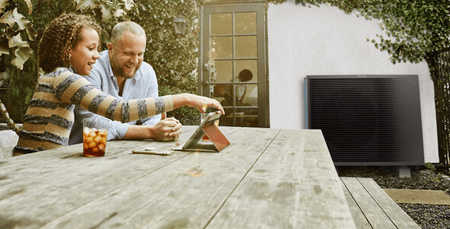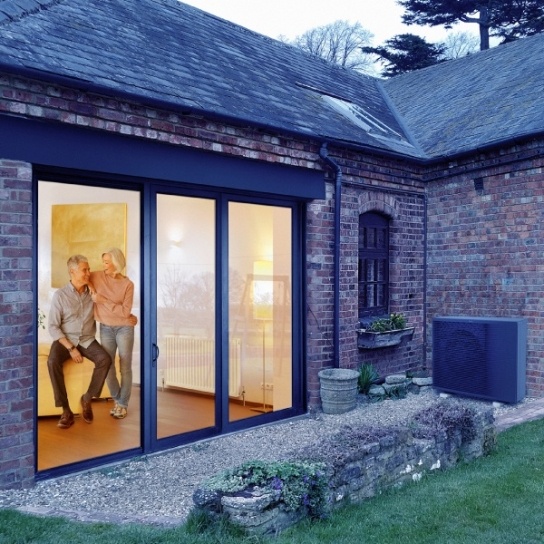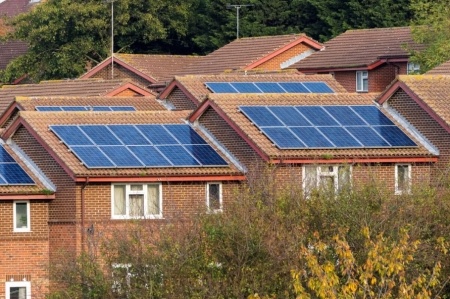
Living the best life with your air source heat pump
The UK is working on catching up with other European countries when it comes to installing air source heat pumps, and as more homes switch from traditional gas boilers, we get more understanding of what living with an air source heat pump is like. We know more than ever about how air source heat pumps perform in the UK, whether they work in older properties and how they hold up in cold winter weather. Just as importantly, we’ve got a growing number of homeowners who can share first-hand tips on enjoying life with an air source heat pump.
Most people with an air source heat pump talk about it positively. According to a report from the social innovation think tank Nesta last year, 81% of UK homeowners who have installed an air source heat pump say they're satisfied or very satisfied with their new system. The same report found that 83% of those installing heat pumps in older properties were pleased with their decision. What's more, air source heat pump owners were more likely to say they were satisfied with the costs of heating their homes than owners of gas boilers. The consensus is clear that air source heat pumps work in the UK and not just for new-build homes.
Dig into the stories of people with air source heat pumps installed, and you find that it’s not just a case of switching on the heat pump and carrying on as normal. Living your best life with an air source heat pump involves adjusting to the subtle differences in how your new heating system works. The Nesta research shows that heat pumps can warm UK homes just as effectively as a traditional boiler, if not more so, but they go about it in a different way. Our customers and our heat pump installation teams find that embracing the differences in how heat pumps work is the key to getting the most from them.
Here are some of the key insights from customers and installers about how to enjoy life with an air source heat pump:
Keep your heat pump running around the clock
One of the first lessons that air source heat pump owners learn is that it costs less to keep your heat pump running all the time, day and night than it does to turn it off and on. Air source heat pumps have a lower flow temperature (the temperature of the water that they pump through your system) than gas boilers, which makes them much more energy efficient. They’re designed to keep your home at a constant temperature rather than pumping out a lot of heat quickly. You'll save very little money by turning an air source heat pump off for a few hours. Instead, you'll force it to use more energy, working harder to get your home back up to temperature. Set your thermostat to the temperature you want your house to be, and then leave your heat pump running to keep it that way. If you prefer a cooler home at night, you can set your heat pump to drop the temperature for a few hours.
Say goodbye to blazing hot radiators
One of the first changes that many air source heat pump owners notice is that their radiators no longer get as hot as they used to. This is another result of the slow and steady way that a heat pump warms your home. Gas boilers overshoot by pumping much more heat than you need into radiators for a short space of time and then leaving them to cool. If you struggle with sinus congestion or asthma, you'll be familiar with some of the side effects of this constantly changing temperature and the very dry air that it creates. Overly hot radiators don't make for a healthy environment.
Air source heat pumps are much more efficient because they warm your whole home to the temperature you actually want without wasting energy. It’s like the difference between the tortoise and the hare in the old fable, and we all remember which approach works best. With an air source heat pump, you won’t be able to warm up your hands quickly by holding them close to the radiator. On the other hand, you won’t need to. You'll probably find yourself breathing more easily too.
Take control of your hot water
Air source heat pumps don't just give you more control over the temperature of your home. They also give you much more control over the temperature of your water. Traditional boilers often deliver hot water at a temperature close to 70°C, which is hotter than you can actually use. You end up having to add cold water, wasting both water and energy and adding to your bills.
Set the water temperature for your air source heat pump to between 48°C and 50°C, and you’ll have water at the right temperature for a bath, shower or sink of dishes while saving money. Your heat pump will run a weekly cycle that heats your stored water to 60°C to kill any bacteria, and the rest of the time it will get on with delivering your water at the temperature you really want.
Don’t turn radiators off – let your rooms keep warm together
Many of us are used to the idea of choosing which rooms we need to keep warm and which ones we can leave to go cold. After all, it doesn’t make sense to pay to heat a room with nobody in it. However, this approach won’t really work with an air source heat pump, which is designed to keep your whole house at a comfortable temperature.
If you turn off radiators in certain rooms, you’ll throw out the balance of your system. Asking your heat pump to heat fewer rooms than it was designed to causes it to shut down more often, which makes it harder to maintain a constant temperature, and can end up using more energy. This is exacerbated by the way that the cold walls of one room start to cool the rooms next to it in a domino effect, increasing the workload.
It seems counter-intuitive, but the most energy-efficient (and cost-efficient) way to heat your home with an air source heat pump is to warm all of it. As an added benefit, you won't end up shivering when you need to go and retrieve something from one of your cold, unused rooms.
Use weather compensation settings to save money on bills
You can set up your air source heat pump to respond to the temperature outside so that it increases the flow temperature of your system when it’s colder and reduces it when it’s warmer. Experimenting with your weather compensation settings helps your air source heat pump keep your home up to the temperature you’ve specified on your thermostat without using more energy than it needs to on warmer days. Different heat pumps have different types of weather compensation settings. Your installer will set them up for you and show you how to adjust them.
Think twice before giving your heat pump a holiday
If you’re going away for a break, you might be tempted to give your heat pump a holiday too. However, our installers advise against turning it off completely. Your heat pump will need to use more energy getting your home back up to temperature than it would keeping it warm while you're away. If you wait to turn your heat pump on until you walk back through the door, you'll have to wait to be warm while it catches up.
Heat pumps warm homes more slowly, but much more efficiently and it's almost always best to leave them running. The best approach is to leave them on normally if you're away for the weekend, and turn them down or use a holiday setting if you're gone for a week or more. Set your heat pump to return to normal running two or three days before you get back.
Don’t worry about your air source heat pump icing up
It shouldn’t really be a surprise that air source heat pumps work really well in cold weather. After all, they’re very popular in Scandinavia and Germany, in places that have much colder winters than the UK.
When the temperature drops dramatically, you might find that ice forms on the outside of your heat pump unit from the cold air that you’re pulling in. This is completely normal, and no cause for concern. You’ll find that the air source heat pump runs its own defrost cycle to remove the ice, and you’ll see what looks like steam rising from it.
Keep a ‘weed watch’ on your air source heat pump unit
It sounds really obvious, but one of the biggest differences between your air source heat pump and a traditional boiler is that your heat pump lives outside. Nobody’s ever needed to weed out vegetation from the cupboard where a boiler sits. However, it’s worth keeping an eye on the area around your air source heat pump and getting rid of any leaves, plants or branches that are getting in the way of vents or pipes. Clear away any other debris, rubbish or garden toys from the areas around it, too. The instructions that come with your heat pump will give you the details of what to look out for in order to keep it running at its best.
Book regular annual services to maintain your warranty
We recommend booking a regular, annual service for your air source heat pump, which will help maintain its manufacturer's warranty and keep it working at its best. Air source heat pumps usually require less maintenance than a traditional boiler, so you'll probably find the annual check-up to be quicker and more straightforward than you're used to.
Visit someone with an air source heat pump to see for yourself
Nesta has launched a new scheme for people interested in air source heat pumps to visit homes that already have them. If you’re considering getting an air source heat pump, it’s a great opportunity to ask real homeowners the questions you can’t find answers to online. If you’re already enjoying life with an air source heat pump, you can sign up to become a host and share your experience with others.

Looking for more information about heat pumps?
Our comprehensive heat pump guide explains the workings of a heat pump and provides valuable information on what to consider before installation and the benefits of doing so.

Ready to buy a heat pump?
We handle everything for your low-carbon heating transition, from survey to installation. Our expert engineers will design a heat pump to keep your home comfortable. Answer a few questions for a callback from our team.

Heat pump installation grants available
Anyone living in England, Scotland or Wales can apply for government grants that cut the cost of installing an air source heat pump. Find out which grants you can apply for.
Related articles

Are solar panels worth it?

Should I fix my energy tariff?
